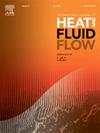Modification of burst events in the near-wall region of turbulent boundary layers by synthetic jets
IF 2.6
3区 工程技术
Q2 ENGINEERING, MECHANICAL
International Journal of Heat and Fluid Flow
Pub Date : 2025-01-04
DOI:10.1016/j.ijheatfluidflow.2024.109728
引用次数: 0
Abstract
Burst events in the near-wall region of turbulent boundary layers are the main contributors to skin friction drag in wall flows. This paper shows how synthetic jets modify the near-wall burst events in turbulent boundary layers, leading to local drag reduction. Different characteristics of synthetic jets including various non-dimensional jet frequencies, ranging from 0.025 to 0.063, at two non-dimensional jet amplitudes of 0.1 and 0.2 were examined by conducting hot-wire measurements at a Reynolds number of 1050. Statistical analysis utilizing a variable-interval time-averaging (VITA) technique illustrated a reduction of up to 15% in burst intensity and a decrease of approximately 10% in burst durations within the near-wall region, , indicating that synthetic jets lifted turbulent kinetic energy and weakened burst events in this region. Consequently, there was a reduction of up to approximately 14% in turbulence intensity near the wall, contributing to diminished shear stresses and local skin-friction drag. Furthermore, the synthetic jets generated a displacement of the inner peak of turbulent energy away from the wall, indicating that the synthetic jets shifted turbulent kinetic energy away from the wall. As the jet frequency or amplitude increased, the modification of the boundary layer became more pronounced.
求助全文
约1分钟内获得全文
求助全文
来源期刊

International Journal of Heat and Fluid Flow
工程技术-工程:机械
CiteScore
5.00
自引率
7.70%
发文量
131
审稿时长
33 days
期刊介绍:
The International Journal of Heat and Fluid Flow welcomes high-quality original contributions on experimental, computational, and physical aspects of convective heat transfer and fluid dynamics relevant to engineering or the environment, including multiphase and microscale flows.
Papers reporting the application of these disciplines to design and development, with emphasis on new technological fields, are also welcomed. Some of these new fields include microscale electronic and mechanical systems; medical and biological systems; and thermal and flow control in both the internal and external environment.
 求助内容:
求助内容: 应助结果提醒方式:
应助结果提醒方式:


